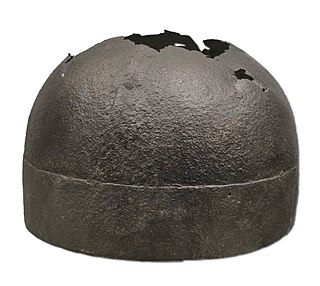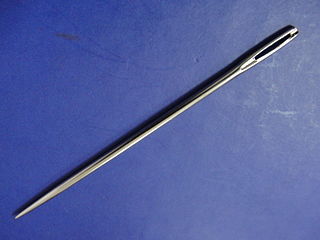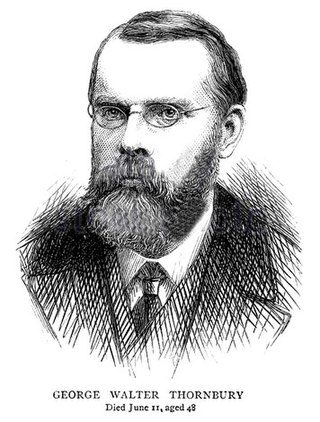Related Research Articles

George Villiers, 1st Duke of Buckingham, KG(; 28 August 1592 – 23 August 1628), was an English courtier, statesman, and patron of the arts. He was a favourite and possibly also a lover of King James I of England. Buckingham remained at the height of royal favour for the first three years of the reign of James's son, King Charles I, until a disgruntled army officer assassinated him.

Watercolor or watercolour, also aquarelle, is a painting method in which the paints are made of pigments suspended in a water-based solution. Watercolor refers to both the medium and the resulting artwork. Aquarelles painted with water-soluble colored ink instead of modern water colors are called aquarellum atramento by experts. However, this term has now tended to pass out of use.

Frederick William Fairholt was an English antiquary and wood-engraver.

A cervelliere is a hemispherical, close-fitting skull cap of steel or iron. It was worn as a helmet during the medieval period.

In heraldry, an escutcheon is a shield that forms the main or focal element in an achievement of arms. The word can be used in two related senses. In the first sense, an escutcheon is the shield upon which a coat of arms is displayed. In the second sense, an escutcheon can itself be a charge within a coat of arms.

A petticoat or underskirt is an article of clothing, a type of undergarment worn under a skirt or a dress. Its precise meaning varies over centuries and between countries.

A sewing needle, used for hand-sewing, is a long slender tool with a pointed tip at one end and a hole to hold the sewing thread. The earliest needles were made of bone or wood; modern needles are manufactured from high carbon steel wire and are nickel- or 18K gold-plated for corrosion resistance. High quality embroidery needles are plated with two-thirds platinum and one-third titanium alloy. Traditionally, needles have been kept in needle books or needlecases which have become objects of adornment. Sewing needles may also be kept in an étui, a small box that held needles and other items such as scissors, pencils and tweezers.

Shag, also known as rolling tobacco or loose tobacco is fine-cut tobacco, used to make self-made cigarettes by hand rolling the tobacco into rolling paper or injecting it into filter tubes. It got its name from the finely cut strands appearing like 'shag' fabric and was originally considered poor quality. Various types of cut are used; most shag blends use a simple mixture of cutting styles, consisting mostly of loose cut but also krumble kake, ribbon cut and flake may be used. Some shag blends use cuts reminiscent of pipe tobacco. These were imported to the United Kingdom by Rory Innes following the Virginia tobacco plantations in North America.

George Walter Thornbury was an English author. He was the first biographer of J. M. W. Turner.

Lord Augustus William Frederick Spencer Loftus, was a British diplomat and colonial administrator. He was Ambassador to Prussia from 1865 to 1868, to the North German Confederation from 1868 to 1871 and to the Russian Empire from 1871 to 1879 and Governor of New South Wales from 1879 to 1885.

A gown, from the Saxon word, gunna, is a usually loose outer garment from knee-to-full-length worn by men and women in Europe from the Early Middle Ages to the 17th century, and continuing today in certain professions; later, the term gown was applied to any full-length woman's garment consisting of a bodice and an attached skirt. A long, loosely fitted gown called a Banyan was worn by men in the 18th century as an informal coat.
"Banded mail" is a neologism, coined in the 19th century, describing a type of composite armor formed by combining the concepts behind the Roman lorica segmentata with splint armour. Its historicity is doubtful. It has become entrenched in the popular consciousness as a result of its inclusion in the armor list for Dungeons & Dragons.

The Art Journal was the most important British 19th-century magazine on art. It was founded in 1839 by Hodgson & Graves, print publishers, 6 Pall Mall, with the title Art Union Monthly Journal, the first issue of 750 copies appearing 15 February 1839. It was published in London but its readership was global in reach.

Surtout was a kind of overcoat. A "surtout" was a 17th-century term used to describe a coat worn over another coat, like a waistcoat. Surtout was a new name for it; prior to 1684, it was known as "Suravit" on account of Surhabit (overcoat).
The following lists events that happened during 1823 in New Zealand.

Llewellynn Frederick William Jewitt was a British illustrator, engraver, natural scientist and author of The Ceramic Art of Great Britain (1878). His output was prodigious and covered a large range of interests.

An anelace was a medieval dagger worn as a gentleman's accoutrement in 14th century England.

A cigar cutter is a mechanical device designed to cut one end off a cigar so that it may be properly smoked. Although some cigars are cut on both ends, or twirled at both ends, the vast majority come with one straight cut end and one end in a "cap" which must be cut off for the cigar to be smoked. Most quality handmade cigars, regardless of shape, will have a cap which is one or more small pieces of a wrapper pasted onto one end of the cigar with either a natural tobacco paste or with a mixture of flour and water. The cap end of a cigar is the rounded end without the tobacco exposed, and this is the end one should always cut. The cap may be cut with a knife or bitten off, but if the cap is cut jaggedly or without care, the end of the cigar will not burn evenly and smokeable tobacco will be lost.

Preparing for a Fancy Dress Ball, also known as The Misses Williams-Wynn, is a 173 by 150 cm oil on canvas by English artist William Etty, first exhibited in 1835 and currently in the York Art Gallery. Although Etty was then known almost exclusively for history paintings featuring nude figures, he was commissioned in 1833 by Welsh Conservative politician Charles Watkin Williams-Wynn to paint a portrait of two of his daughters. Preparing for a Fancy Dress Ball shows Williams-Wynn's daughters, Charlotte and Mary, in lavish Italian-style costume: Charlotte, the eldest, is shown standing, helping the seated Mary decorate her hair with a ribbon and a rose. Etty put a good deal of effort into the piece and took much longer than usual to finish it.
James Day was an English verse-writer whose name and writings are but little known.
References
- ↑ Wilcox, R. Turner (Ruth Turner) (1969). The dictionary of costume. Internet Archive. New York, Scribner. p. 400.
- ↑ Lewandowski, Elizabeth J. (2011-10-24). The Complete Costume Dictionary. Scarecrow Press. p. 317. ISBN 978-0-8108-7785-6.
- ↑ "Definition of WRAPRASCAL". www.merriam-webster.com. Retrieved 2022-02-07.
- ↑ Fairholt, Frederick William (1896). Costume in England: Glossary. G. Bell and sons.
